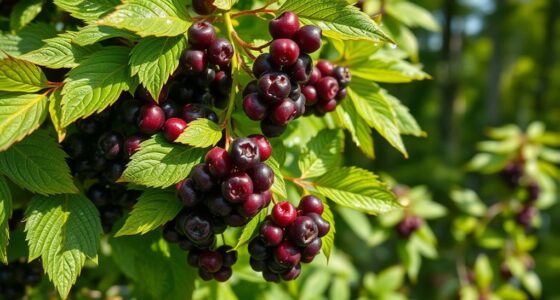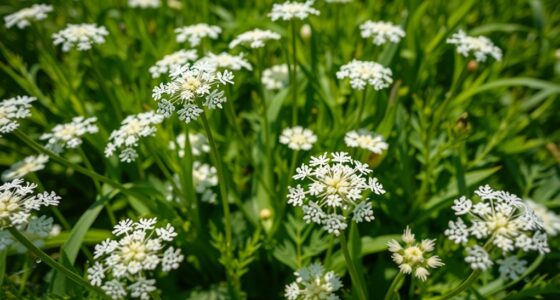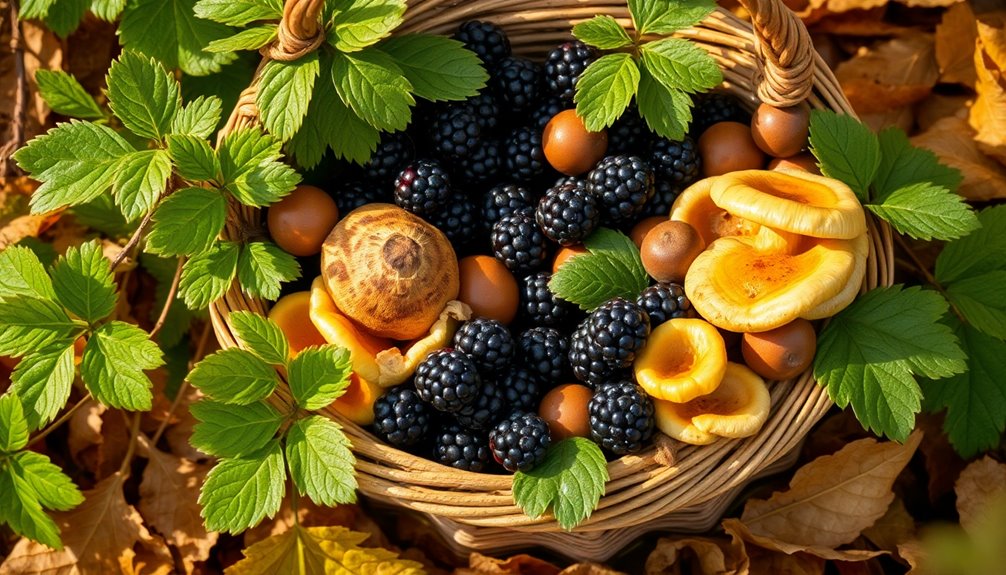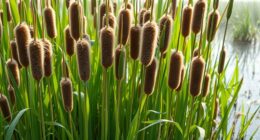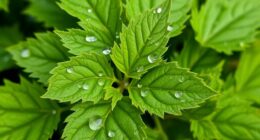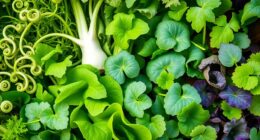Discover the world of morel mushroom hunting, where you will find these hidden culinary delicacies in the woods. Morels are easily recognizable by their hollow cup-like shape and come in colors such as yellow and black, prized for their unique appearance and earthy flavor. They can be found near certain trees or in areas that have been burned, which makes cultivating them a challenge. To locate them, search during mid-April to early summer when the ground temperature reaches 50-55°F after spring showers. Keep an eye out for fairy cup mushrooms, as they indicate prime mushroom hunting locations. Experience the excitement of uncovering these treasures while surrounded by nature’s beauty.
Key Takeaways
- Morels thrive in specific habitats like riverbanks and burn scars.
- Hunt during peak season with ground temperatures of 50-55°F.
- Look for fairy cup mushrooms as indicators of ideal morel habitat.
- Properly identify true morels for safe foraging and cooking.
- Preserve morels by rinsing, cooking thoroughly, and drying or freezing.
Morel Mushroom Characteristics
Morel mushrooms, belonging to the genus Morchella, are distinguished by their hollow cup-like structure and varying shapes and colors, such as yellow and black. These elusive fungi are prized by foragers for their unique appearance and earthy flavor.
Morels have a fascinating way of growing, often being found near specific tree types or in forest fire burn scars. The aftermath of a forest fire creates the perfect conditions for morels to thrive, as they feed on the decaying organic matter left behind.
Despite their culinary desirability, cultivating morels is a challenging task due to their specific environmental requirements. Morels produce resting structures called sclerotia, which aid in their growth and reproduction.
Their distinctive texture and rich flavor make finding morel mushrooms an exciting and rewarding experience for mushroom enthusiasts. Keep exploring the forests, and you might just stumble upon these hidden gems waiting to be discovered.
Best Time to Hunt Morels
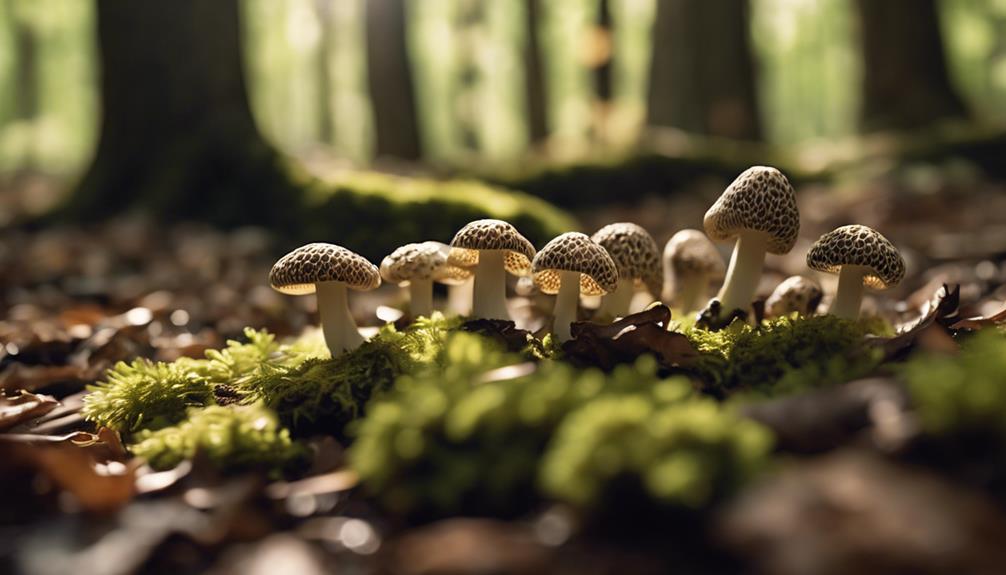
To optimize your morel hunting experience, keep an eye out for the peak season when these elusive mushrooms are in abundance.
Pay close attention to the weather conditions, ensuring ground temperatures of 50-55°F after spring rains or snow melts.
Identifying habitat hotspots and native plant indicators like redbuds can lead you to the prime locations for morel hunting.
Peak Morel Season
During peak morel season, timing your foraging trips is crucial for maximizing your harvest. Peak morel season in Montana typically spans from mid-April to early summer. To guarantee success, aim for ground temperatures around 50-55°F following spring rains and snow melts. Yellow morels gravitate towards riverbanks and creek beds in valley bottoms, while black morels flourish in forest fire burn scars found at higher elevations.
Keep an eye out for specific tree types like cottonwood and aspen stands, which attract yellow morels, whereas black morels prefer slopes and areas around trees. Additionally, spotting fairy cup mushrooms can indicate an ideal habitat for morel hunting. By targeting the peak morel season and understanding the ideal hunting conditions and environments favored by these elusive fungi, you can greatly increase your chances of a bountiful harvest.
Ideal Weather Conditions
Timing your foraging trips for morel mushrooms hinges on the ideal weather conditions and the best time to hunt them. Morel mushrooms are particularly sensitive to weather conditions, with ground temperatures around 50-55°F being best for their growth.
The best time to begin your morel hunting adventure is typically from mid-April through early summer in Montana.
Ideal weather conditions play a pivotal role in the morel fruiting process. Spring rains and snow melts are essential factors that trigger the fruiting of these elusive mushrooms. These conditions create the perfect environment for morels to emerge from the forest floor.
Habitat Hotspots
When searching for morel mushrooms, focus on habitat hotspots to increase your chances of a successful foraging experience. Morels can be elusive, but knowing where to look can make all the difference. In Montana, ideal hunting season for morels ranges from mid-April to early summer when the ground temperatures hover around 50-55°F after spring rains. Look for specific tree types such as old growth cottonwood and aspen stands for yellow morels, while black morels, also known as Fire Morels, thrive in forest fire burn scars, especially at higher elevations. These burn scars are hotspots for finding black morels, commonly located on slopes and around trees in those areas. Remember that morels favor habitats with Fairy Cup mushrooms, which can indicate potential hotspots for successful foraging. By targeting these habitat hotspots during the ideal hunting season, your morel mushroom hunting experience can be both rewarding and fruitful.
| Habitat Hotspots for Morels | |
|---|---|
| Old growth cottonwood and aspen stands | Yellow morels |
| Forest fire burn scars at higher elevations | Black morels |
| Habitats with Fairy Cup mushrooms | Potential hotspots |
Ideal Morel Mushroom Habitats
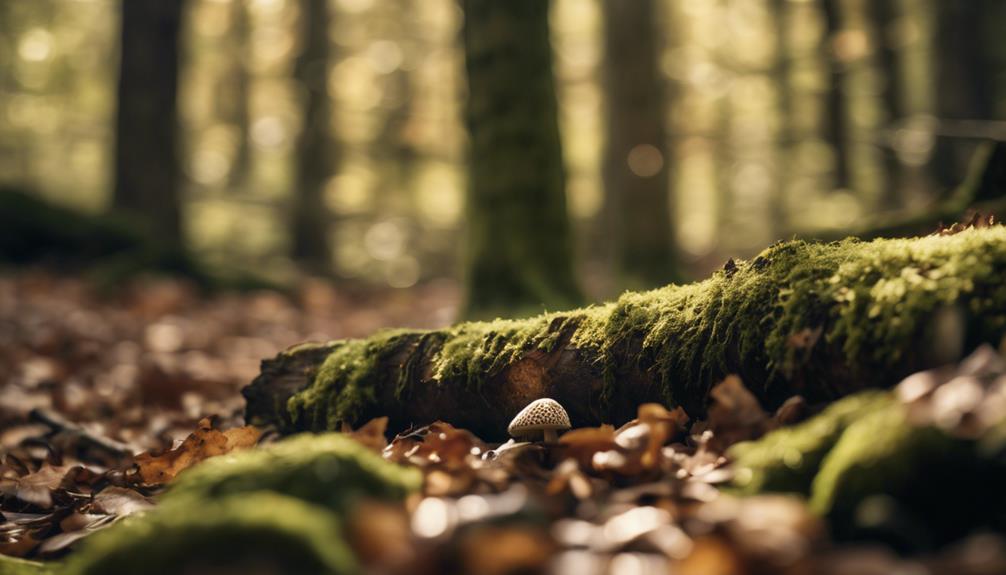
Ideal morel mushroom habitats encompass a range of forest floor conditions, with specific preferences for tree species like elms, ash, and apple trees.
These mushrooms thrive in moist environments near rivers, creeks, and valley bottoms, requiring the right balance of moisture and sunlight.
Understanding these key factors can greatly enhance your foraging success when hunting for these elusive fungi.
Forest Floor Conditions
Exploring forest floor conditions is key to uncovering ideal habitats for morel mushrooms, where specific soil temperatures and environmental factors play an essential role in their growth and development. Morels, often camouflaged among the forest floor debris, can be challenging to spot. To maximize your foraging success, consider the following forest floor conditions that create the perfect environment for morel mushrooms:
| Forest Floor Conditions | Description |
|---|---|
| Soil Temperatures | Morels thrive at 50-55°F |
| Near Water Sources | Ideal for yellow morels |
| Burn Scars | Preferred by black morels |
| Slopes and Trees | Black morels habitat |
| Fairy Cup Mushrooms | Contribute to an ideal habitat |
Tree Species Preference
To successfully locate morel mushrooms in their natural habitats, understanding the preferred tree species is essential. Morel mushrooms have a particular affinity for tree species like cottonwood and aspen, especially in valley bottoms.
If you're on the hunt for yellow morels, keep an eye out near rivers and creeks, while black morels tend to thrive in forest fire burn scars at higher elevations. These black morels can persist on slopes and around trees in burnt areas for years post-fire.
Moisture and Sunlight
Look for morel mushrooms in moisture-rich environments where sunlight hits the ground, such as under bushes along streets. When searching for these hidden gems, keep in mind that moisture is key to their growth, making shady areas and locations where sunlight hits moist ground ideal habitats.
To maximize your chances of finding morels, focus on areas that retain water and provide the perfect conditions for these prized mushrooms to flourish. Here are some tips to help you locate morels:
- Explore hedgerows and shady areas where moisture is abundant.
- Check under bushes along streets where sunlight hits the moist ground.
- Look for spots like ditches and runoff areas that retain water, creating a favorable environment for morels.
- Search grass patches between buildings or in overgrown areas, as these locations tend to stay moist and can yield a bountiful harvest of morel mushrooms.
Essential Gear for Morel Foraging
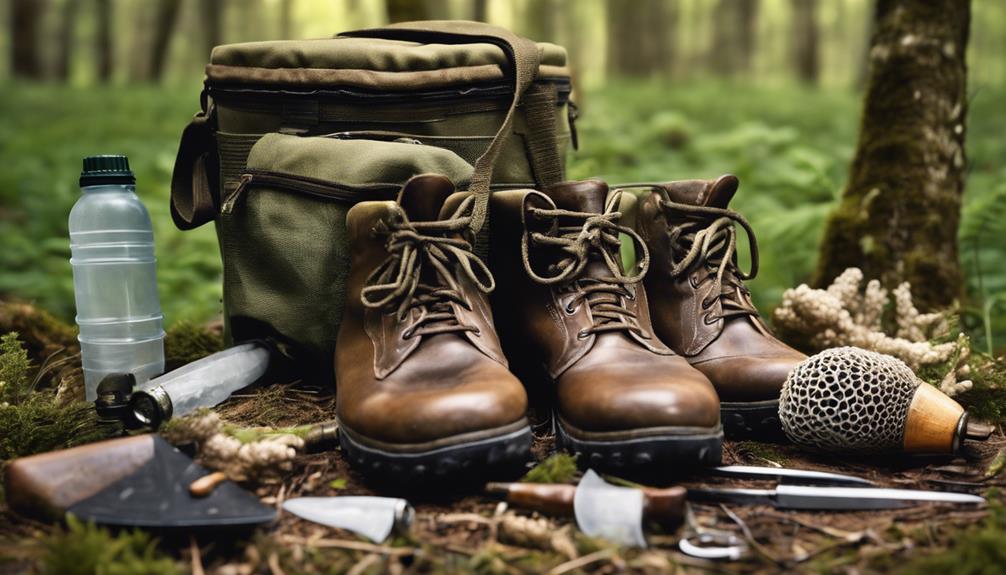
Setting out, essential, guarantee, furthermore
Carrying mesh bags or baskets is essential for allowing spores to sift out while foraging for morels. These bags help in dispersing spores as you move, aiding in the growth of more mushrooms in the future. Additionally, a sharp knife is a must-have tool for cutting morels at the base. By doing so, you guarantee the sustainability of the morel population in the area you're foraging.
As you venture out for morel mushroom hunting, don't forget your mushroom identification books or field guides. These resources are essential for safely identifying edible morels from toxic look-alikes. Furthermore, before heading out, make sure to obtain permits and check regulations for harvesting on public lands. Compliance with local laws is essential for preserving these natural treasures for future foragers.
Equipped with mesh bags, a sharp knife, mushroom identification books, and necessary permits, you're now ready to set out on a successful morel foraging expedition.
Identifying Edible Morels

Edible morels can be easily distinguished by their distinctive honeycomb appearance and hollow stems. To help you identify these prized mushrooms, here are some key characteristics to look out for:
- True morels have caps attached directly to the stem, unlike false morels.
- The cap color of morels can range from yellow to black, depending on the species.
- Edible morels are prized for their rich, nutty flavor and meaty texture when cooked.
- Proper identification of morels is important to avoid consuming toxic look-alikes.
- Remember, when foraging for morels, always make sure that you're confident in distinguishing between edible and toxic varieties. It's vital to be cautious and knowledgeable when it comes to identifying these mushrooms to enjoy their delicious taste safely.
Cooking and Preserving Morels
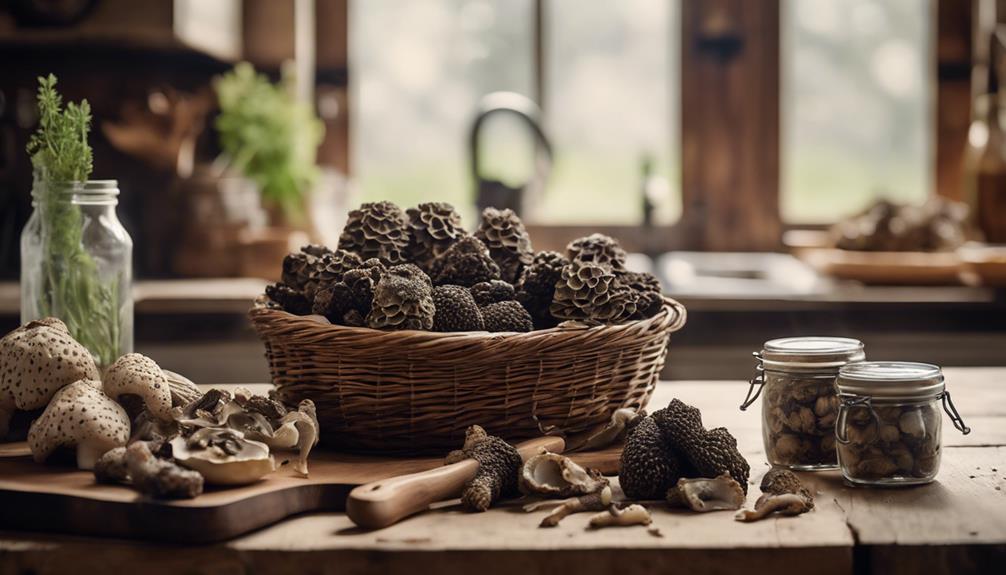
To fully enjoy the earthy flavor of morels, it is important to know how to properly cook and preserve these prized mushrooms. When cooking morels, start by rinsing, trimming, and soaking them in salt water to remove any bugs that may be hiding in their crevices. Make sure thorough cooking to prevent allergic reactions, as undercooked morels can trigger adverse responses in some individuals. Incorporate these delicious fungi into dishes like pasta, omelets, and risottos to elevate their flavors with a unique earthy taste.
For long-term storage, consider preserving morels through air drying, dehydrating, or freezing. When preserving, it's essential to heat the morels to 165°F to eliminate any insect eggs that might be present. By following these cooking and preserving techniques, you can savor the delightful taste of morels while ensuring they are safe to eat. Below is a helpful table summarizing the key points for cooking and preserving morels:
| Cooking & Preserving Morels |
|---|
| Rinse, trim, and soak in salt water to remove bugs |
| Cook thoroughly to avoid allergic reactions |
| Enhance dishes like pasta, omelets, and risottos |
| Preserve by air drying, dehydrating, or freezing |
Frequently Asked Questions
Where Is the Best Location for Morels?
For the best location to find morels, head to areas near rivers and creeks in valley bottoms. Look for black morels in forest fire burn scars at higher elevations. Ideal spots have specific tree types and slopes.
What Time of Day Is Best to Find Morels?
When searching for morels, aim for the early morning or late afternoon. These times offer cooler temperatures, ideal conditions for these hidden gems. Daylight aids visibility, allowing you to cover more ground and up your chances of success.
Do Morels Pop up Overnight?
Morels don't pop up overnight; they mature over 7 to 14 days. Check spots twice weekly to spot them. Ground temperatures matter for morel emergence. Soil temps dictate when they fruit. Redbuds may hint at morels' arrival.
Why Are Morels so Hard to Find?
Morels are hard to find due to their camouflaged appearance and unique growing conditions. Their ability to blend in with surroundings, combined with their specific habitat preferences, makes locating these elusive mushrooms a challenging task.
Conclusion
Now that you have all the information you need to hunt for morel mushrooms, don't let uncertainties hold you back.
While it may seem challenging at first, with the right gear and knowledge, you'll be on your way to discovering these hidden gems in no time.
Remember, the thrill of the hunt and the delicious reward at the end make the effort well worth it.
Happy foraging!




